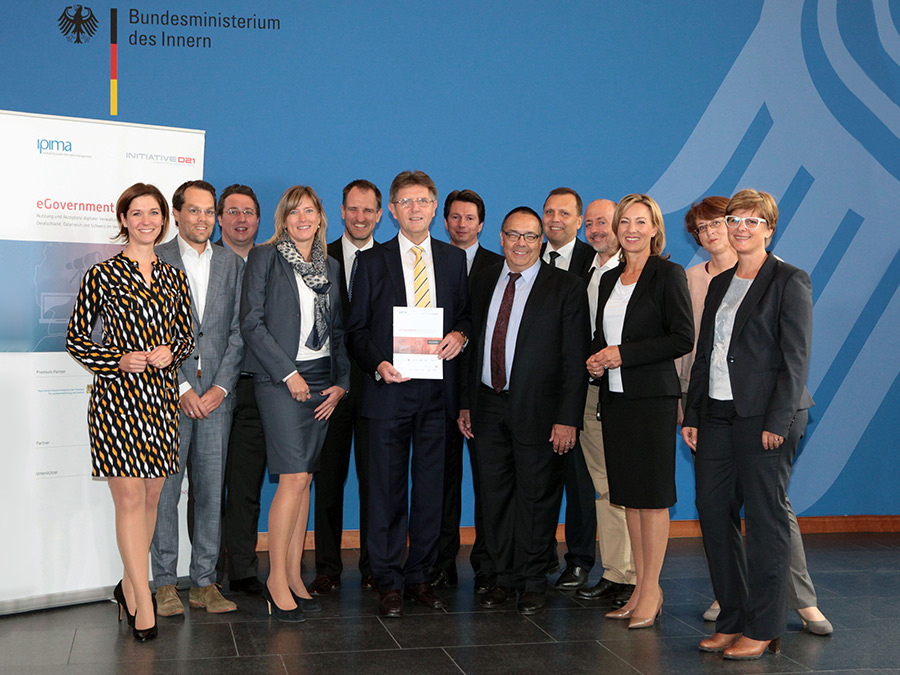eGovernment MONITOR analyzes utilization of digital administrative services
Skepticism towards digital administrative services is declining

Not even every second online user in Germany takes advantage of e-government services: This year it was merely 45 percent. Large infrastructure projects like online personal ID functions and DE-mail remain widely unknown and unused.
45 percent of German online users have no DE-mail account and have no intention of applying for one in the future. 35 percent of the respondents are not even aware of the service. Hardly anyone in Germany opts to activate the online personal ID function and purchase the requisite reader.
Ultimately, only four percent of German internet users make full use of a digital personal ID (nPA). 16 percent of the respondents were even advised by government officials not to activate their IDs.
Good portents for increasing utilization of e-government services in Germany
Yet, the current eGovernment MONITOR shows something unusual: In all three countries, concerns about data security and protection have alleviated and have reached the lowest levels since the survey started. In Germany, trepidation dropped by half compared to 2014 (32 percent in Germany, 27 percent in Austria, 16 percent in Switzerland).
Confidence in digital administrative services has thus increased significantly. Overall, the queried online users show great interest in e-government services, whether citizen information services or open government services. In addition, users of e-government services are more satisfied than in years past. Here too, the figure of 62 percent in Germany is the highest since the study started.
German respondents, who traditionally make much less use of e-government services than the respondents in the other countries, however, had a surprising level of utilization: When German citizens do choose to use digital administrative services, they use e-government as frequently as the Swiss and Austrians – on average 3.1 times per year.
This portends well for the increasing utilization of e-government services in Germany. But, there is still a lack of efficient, device-independent and user-relevant services. Due to these barriers the e-government utilization rate in Germany is increasing only marginally (up six percent from 39 to 45 percent) and stagnating in the long-term trend.
Fewer clicks for relevant information henceforth
“As a high technology country, Germany is dependent on a functioning administration,” says State Secretary Klaus Vitt. “In times of technology change, the German administration can remain viable only if online services are expanded further.”
“We have made progress in digitalization,” continues Vitt, “but overall, we are not where we need to be, by far. Only if we succeed in making online public administration services more attractive and accessible will citizens and businesses handle their administrative matters digitally.”
“The federal government, in collaboration with the states and municipalities, is thus planning on intelligently interconnecting administration portals. We want to link these to digital citizen and company accounts. This will then allow users to find all relevant information with only a few clicks and immediately take advantage of the desired services, as required. E-government needs to be that direct, easy and fast,” says Vitt.
Not defeating yourself and integrating latest technology
“In the past five years the administration has made strides to advance its own digitalization,” emphasizes Prof. Helmut Krcmar of the Institute for Public Information Management (ipima), an initiative of the TUM Department of Information Systems and fortiss GmbH, an affiliated institute of TU Munich.
He believes, “the biggest user barriers remain low levels of awareness, a lack of consistency and unintelligibly structured service offers – all barriers that administrations can influence directly. So, it is in the hands of administrations to motivate citizens for their services. They are open to new ideas and administrations would be well advised to undertake experiments to take full advantage of the potential of digitalization.”
Hannes Schwaderer, president of the Initiative D21 also thinks that the full user potential is not being utilized. Once supply and demand square up, services are well advertised and users are satisfied with the services, “e-government will finally become a success story in Germany, as well. Technological advances will enable a less bureaucratic and customer-oriented administration.”
“I can envision chatbots, for example, that walk e-government users through forms with simple dialogs, helping them fill them out,” says Hannes Schwaderer. “These kinds of novel, assistance services can support the automation of common processes and create efficient and flexible processes outside of opening hours to satisfy user needs and reduce the workload of administration staff.”
E-government use: a question of education
While users of administration services show hardly any differences between age and sex – e.g. nearly the same number of men and women, young and old people use e-government services – when it comes to the level of education, there is a significant disparity in the utilization rate.
There is a gap of around 31 percent between the utilization rate of well and poorly educated people (72 percent for the well-educated, 60 percent for the poorly educated). Highly educated people obviously understand the advantages of digital administration much better. Here, there is a need for action and for investigating the reasons behind the lower acceptance rate by people with a lower level of education.